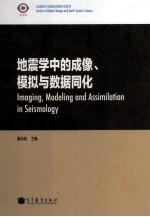图书介绍
地震学中的成像、模拟与数据同化 英文版PDF|Epub|txt|kindle电子书版本网盘下载

- 郦永刚主编 著
- 出版社: 北京:高等教育出版社
- ISBN:9787040343410
- 出版时间:2012
- 标注页数:263页
- 文件大小:42MB
- 文件页数:272页
- 主题词:地震数据-数据处理-英文
PDF下载
下载说明
地震学中的成像、模拟与数据同化 英文版PDF格式电子书版下载
下载的文件为RAR压缩包。需要使用解压软件进行解压得到PDF格式图书。建议使用BT下载工具Free Download Manager进行下载,简称FDM(免费,没有广告,支持多平台)。本站资源全部打包为BT种子。所以需要使用专业的BT下载软件进行下载。如BitComet qBittorrent uTorrent等BT下载工具。迅雷目前由于本站不是热门资源。不推荐使用!后期资源热门了。安装了迅雷也可以迅雷进行下载!
(文件页数 要大于 标注页数,上中下等多册电子书除外)
注意:本站所有压缩包均有解压码: 点击下载压缩包解压工具
图书目录
Imaging,Modeling and Assimilation in Seismology:An Overview1
References11
Chapter 1 Full-Wave Seismic Data Assimilation:A Unified MethodologyforSeismicWaveformInversion19
1.1 Introduction19
1.2 Generalized Inverse21
1.2.1 Prior Probability Densities22
1.2.2 Bayes'Theorem25
1.2.3 Euler-Lagrange Equations26
1.3 Data Functionals31
1.3.1 Differential Waveforms32
1.3.2 Cross-correlation Measurements33
1.3.3 Generalized Seismological Data Functionals (GSDF)34
1.4 The Adjoint Method38
1.4.1 An Example of Adjoint Travel-Time Tomography39
1.4.2 Review of Some Recent Adjoint Waveform Tomography41
1.5 The Scattering-Integral(SI)Method42
1.5.1 Full-Wave Tomography Based on SI44
1.5.2 Earthquake Source Parameter Inversion Based on SI46
1.6 Discussion54
1.6.1 Computational Challenges55
1.6.2 Nonlinearity57
1.7 Summary58
References59
Chapter 2 One-Return Propagators and the Applications in Modeling and Imaging65
2.1 Introduction66
2.2 Primary-Only Modeling and One-Return Approximation67
2.3 Elastic One-Return Modeling72
2.3.1 Local Born Approximation73
2.3.2 The Thin Slab Approximation75
2.3.3 Small-Angle Approximation and the Screen Propagator77
2.3.4 Numerical Implementation80
2.3.5 Elastic,Acoustic and Scalar Cases81
2.4 Applications of One-Return Propagators in Modeling,Imaging and Inversion81
2.4.1 Applications to Modeling81
2.4.2 One-Return Propagators Used in Migration Imaging85
2.4.3 Calculate Finite-Frequency Sensitivity Kernels Used in Velocity Inversion88
2.5 Other Development of One-Return Modeling93
2.5.1 Super-Wide Angle One-Way Propagator93
2.5.2 One-Way Boundary Element Method95
2.6 Conclusion99
References100
Chapter 3 Fault-Zone Trapped Waves:High-Resolution Characterization of the Damage Zone of the Parkfield San Andreas Fault at Depth107
3.1 Introduction107
3.2 Fault-Zone Trapped Waves at the SAFOD Site109
3.2.1 The SAFOD Surface Array111
3.2.2 The SAFOD Borehole Seismographs116
3.2.3 Finite-Difference Simulation of Fault-Zone Trapped Waves at SAFOD Site124
3.3 Fault-Zone Trapped Waves at the Surface Array near Parkfield Town132
3.4 Conclusion and Discussion135
Acknowledgements138
References138
Appendix:Modeling Fault-Zone Trapped SH-Love Waves143
Chapter 4 Fault-Zone Trapped Waves at a Dip Fault:Documentation of Rock Damage on the Thrusting Longmen-Shan Fault Rupturedinthe 2008 M8 WenchuanEarthquake151
4.1 Geological Setting and Scientific Significance152
4.2 Data and Results154
4.2.1 Data Collection154
4.2.2 Examples of Waveform Data157
4.3 3-D Finite-Difference Investigations of Trapping Efficiency at the Dipping Fault164
4.3.1 Effect of Fault-Zone Dip Angle166
4.3.2 Effect of Epicentral Distance169
4.3.3 Effect of Source Depth171
4.3.4 Effect of Source away from Vertical and Dip Fault Zones172
4.3.5 Effect of Fault-Zone Width and Velocity Reduction175
4.4 3-D Finite-Difference Simulations of FZTWs at the South Longmen-Shan Fault175
4.5 Fault Rock Co-Seismic Damage and Post-Mainshock Heal180
4.6 Conclusion and Discussion186
Acknowledgements190
References190
Appendix196
Chapter 5 Ground-Motion Simulations with Dynamic Source CharacterizationandParallelComputing199
5.1 Introduction199
5.2 The Spontaneous Rupture Model200
5.3 EQdyna:An Explicit Finite Element Method for Simulating Spontaneous Rupture on Geometrically Complex Faults and Wave Propagation in Complex Geologic Structure203
5.4 Two Examples of Ground-Motion Related Applications of EQdyna206
5.4.1 Sensitivity of Physical Limits on Ground Motion on Yucca Mountain206
5.4.2 Effects of Faulting Style Changes on Ground Motion209
5.5 Hybrid MPI/OpenMP Parallelization of EQdyna and Its Application to a Benchmark Problem210
5.5.1 Element-size Dependence of Solutions211
5.5.2 Computational Resource Requirements and Performance Analysis215
5.6 Conclusions215
Acknowledgements216
References216
Chapter 6 Load-Unload Response Ratio and Its New Progress219
6.1 Introduction219
6.2 The Status of Earthquake Prediction Using LURR223
6.3 Peak Point ofthe LURR and Its Significance224
6.4 Earthquake Cases in 2008-2009226
6.5 Improving the Prediction of Magnitude M and T2-Application of Dimensional Method227
6.5.1 Location227
6.5.2 Magnitude227
6.5.3 Occurrence time(T2)231
6.6 Conclusions232
Acknowledgements232
References232
Chapter 7 Discrete Element Method and Its Applications inEarthquake and Rock Fracture Modeling235
7.1 Introduction235
7.2 A BriefIntroduction to the Esys_Particle237
7.3 Theoretical and Algorithm Development238
7.3.1 The Equations of Particle Motion238
7.3.2 Contact Laws,Particle Interactions and Calculation of Forces and Torques239
7.3.3 Calibration of the Model242
7.3.4 Incorporation of Thermal and Hydrodynamic Effects243
7.3.5 Parallel Algorithm245
7.4 Some Numerical Results Obtained by Using the Esys_Particle245
7.4.1 Earthquakes245
7.4.2 Rock fracture251
7.5 Coupling of Multiple Physics254
7.5.1 Thermal-Mechanical Coupling254
7.5.2 Hydro-Mechanical Coupling255
7.5.3 Full Solid-Fluid Coupling255
7.6 Discussion and Conclusions256
Acknowledgements258
References258